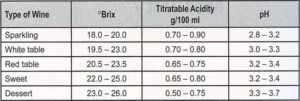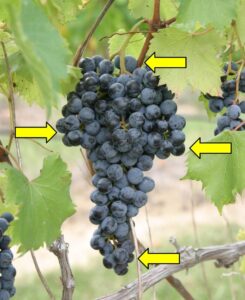By Daniel Ward and Hemant Gohil
It is harvest season and one of the most challenging aspects of wine making is upon us – When to harvest? There is no single combination of physical, chemical, flavor and aromatic composition of grape berries that can be used to decide when to pick, so we need to use our best information and exercise our best judgment.
Instrumental Measurements of Fruit Ripeness: So-called technological maturity is based on primary chemistry; the accumulation of sugars and the loss of acidity, during maturation. Instrumental measurements of primary fruit chemistry for grapes usually consists of measuring the total soluble solids (in units of degrees Brix), total titratable acidity (in percentage or grams per 100ml), and pH. The must or expressed juice from a sample of berries is usually used for this evaluation.
Table 1. Approximate target ranges for primary chemistry measurements for must at harvest.

From Boulton, B., Vernon L. Singleton, Linda F. Bisson, and Ralph E. Kunkee. 1996. Principles and Practices of Winemaking. 1st ed. New York, NY: Chapman and Hall).
The rate of sugar accumulation and reduction in titratable acidity do not always follow the same pattern and are affected by weather fluctuations. Deciding when to harvest in such an uncertain time as the current growing season can challenge any attempt at optimizing harvest and satisfying all parties affected. Below are some important considerations in that regard:
- Ripeness may not be the same as physiological or technical maturity
- Optimal quality may not coincide with specific levels of sugar, TA or pH.
- Under cool growing conditions, peak sugar may be lower, but full flavor can still develop.
- Varieties differ in their sugar levels at the time of optimum flavor.
- Vineyard manager, buyer, and winemaker should discuss and agree upon the definition of maturity that will be used to set price, and the decision of when to harvest.
Judging the Flavor Development: Do not rely on primary chemistry alone to tell you how ripe your fruit is. Sensorial assessments and tasting berries in particular can tell us much about the development of flavor, varietal character, and phenolic maturity. Put the berries in your mouth and crush them, carefully paying close attention to the flavors in the juice being released. Separate the seeds from the pulp and spit them into your hand for observation. Finally crush the berry skin firmly between your rear molars and pay close attention to the degree of astringency, which is related to phenolic maturity. Pay attention to the appearance of new, desirable flavor components, as well as the disappearance of undesirable flavor components.

Figure 1. Order of appearance of flavors in Cabernet Sauvignon during maturation. From: Bisson, L. 2001. In search of optimal grape maturity. Practical Winery & Vineyard. July/August. Pp. 32-43.
Ripening berries can continue to change flavors, even after reaching technological maturity. Day-to-day weather changes also affect the ripening process; hence, regular monitoring of berry ripening is needed.
Sampling: Collect a separate sample for each block of grapes that will be harvested as a unit. A suggested sampling technique is to 1) Collect a sample of at least 100 berries to represent the block, 2) Sample the berries from at least 20 clusters on each of at least 20 vines, 3) Sample from the top, middle, and bottom of each cluster (Figure 2), 4) Alternate between sampling from the East and West sides of the rows. Perform both the instrumental measurements and the sensorial assessments from this sample.

Figure 2. Different positions of the cluster, from which representative berry sample should be collected.
You may use the downloadable datasheet using this link (https://njvines.rutgers.edu/when-to-harvest/ ) to record your observations. As you sample each block in your vineyard, take notes. This will provide you with a helpful harvest reference, this year and years to come. Happy harvesting!

